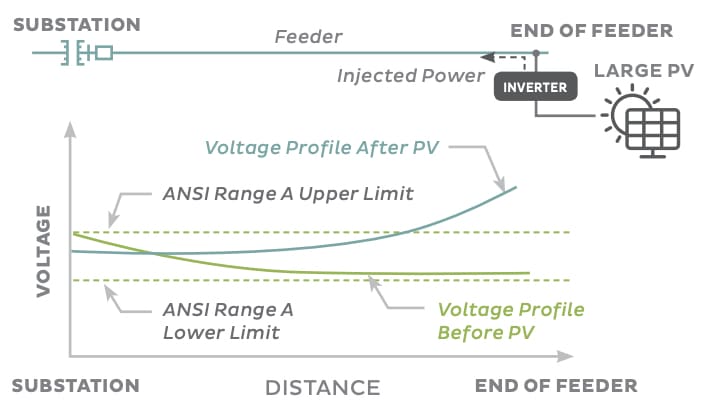Maryland is following Hawaii, California and Minnesota in setting smart inverter rules for distributed solar and storage.
Smart inverters enable more rooftop solar on the grid. Here’s why: although adding rooftop solar with ordinary inverters can increase voltage on a distribution circuit—potentially above the safe range shown by the two dotted lines in the image above—smart inverters can help control voltage. By helping solve the voltage issue that higher levels of rooftop solar can cause, smart inverters can increase the amount of solar a distribution circuit can handle, an amount called the circuit’s hosting capacity.
The Maryland Public Service Commission last week adopted the IEEE 1547-2018 standard for smart inverters, which the state will require for new distributed solar and storage starting January 1, 2022. Sunrun and the Energy Storage Association endorsed the new requirements, according to a press statement from the Interstate Renewable Energy Council (IREC). IEEE is a global standards-setting organization.
Hosting capacity
For states with high renewables goals, adopting smart inverter rules can help meet those goals by increasing hosting capacity, says the Center for Renewables Integration (CRI), in a report titled “It’s time for states to get smart about smart inverters.” The Center advises using a stakeholder process, as Maryland did, and “start now to develop implementation plans.”
The alternative method of increasing hosting capacity, by installing utility-supplied voltage regulation hardware, can be costly. “Being able to add more capacity to the distribution system without incurring distribution upgrade costs is a core purpose” of smart inverters, said Harry Warren, who co-founded CRI and led Maryland’s smart inverter stakeholder process, in a pv magazine interview. “Industry is very interested in these collaborative processes in decision-making, so that maximum advantage can be obtained from these [smart inverters].”
Grid services
A looming question, for states that set smart inverter rules, is whether smart distributed resources will be compensated for the grid services they provide. The answer may partly depend on the smart inverter settings specified in state requirements, and whether third-party aggregators are allowed to aggregate distributed resources, and then compensate the resource owners.
In Pennsylvania, for example, a utility has proposed to “monitor and manage” all newly interconnected distributed energy resources, without making a commitment to compensate the resource owners. Sunrun and the environmental group NRDC are challenging that proposal.
Four states’ approaches
Hawaii and California were the first states to set smart inverter rules, without waiting for the IEEE standard. Both states require activation of a smart inverter’s “volt-var” setting, which enables the inverter to independently regulate voltage. This required setting avoids the expense of a centralized utility communications system and distributed energy resource management (DERM) system. The consultancy GridLab advocates the volt-var approach in a report, which also provides details on the two states’ approaches.
Minnesota last fall became the first state to adopt the IEEE 1547-2018 standard in requiring smart inverters, as reported by IREC Vice President Sara Baldwin. “Volt-var was discussed substantially during the drafting” of the requirements, said IREC’s Chief Regulatory Engineer Brian Lydic in a pv magazine interview, but he said that a different setting was specified, namely “constant power factor mode with a 0.98 power factor.”
“Utilities did not feel comfortable,” Lydic said, “implementing the dynamic [volt-var] function without doing a deeper study of how it would interact with their own distribution systems.” Utilities also raised a concern about “being unable to easily change volt-var settings without a communications and control system in place.” Lydic noted that IREC has advocated for the continued discussion of volt-var utilization in Minnesota as the state’s requirement evolves in the coming years.
In Maryland, smart inverter settings—volt-var or otherwise—will be established through a Phase III stakeholder process that will continue over the next two years.
Sunrun’s Senior Manager of Public Policy Nicole Sitaraman said in a pv magazine interview that Sunrun participates in two Maryland workgroups, on interconnection standards and energy storage, that are “investigating pathways to enable distributed energy resources (DERs) to provide grid services. These working groups will also look at future utility plans to address hosting capacity, which should provide more opportunities for DERs in Maryland to modernize the grid and provide valuable cost savings services to the region.”
The text of the Maryland Public Service Commission’s requirements is available here, starting on page 126 of the document.
This content is protected by copyright and may not be reused. If you want to cooperate with us and would like to reuse some of our content, please contact: editors@pv-magazine.com.








Instead of some kind of utility to residential inverter, communications to change “inverter settings”, use communications between the inverter to the ESS to create their own micro-grid that would “allow” say 500Wh of solar PV during the day to go back onto the grid , while saving the rest of the generated energy in the ESS for later in the afternoon hours and into the nighttime grid demand period. Right now most rote electric utility’s are in the electricity price spiking market and excuse mongering: “When your neighbor installs solar PV it increases your electric rates.” Many are adopting TOU rate spiking from 3 PM to 9 PM every day, then some are already crying about early morning from 6 AM to 9 AM as “another” time frame that “needs” rate spiking. In the future, this tells me the solar PV and smart ESS needs roughly 10 hours of off peak energy storage. On “average” this is about 48kWh of usable energy storage.
This experiment is in the wild, and will provide valuable real world experience for autonomous distributed grid management. “Next-generation power devices is(are) steadily sharing electricity between solar panels, batteries, heaters, and vehicles connected throughout the neighborhood.”
https://www.nrel.gov/news/features/2019/small-colorado-utility-sets-national-renewable-electricity-example-using-nrel-algorithms.html
Please do not use such graphics like this.
The voltage of A PV-system, respectively an inverter will never hit the dashed lines (ANSI Range Limits), instead it will shut down.
And this is no smart inverter feature, this inverters had to grant at any time.